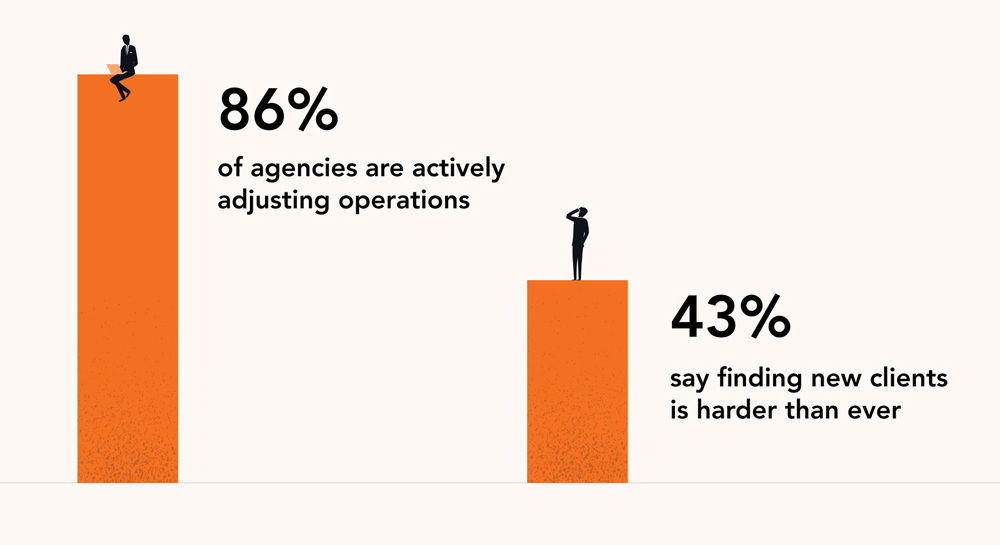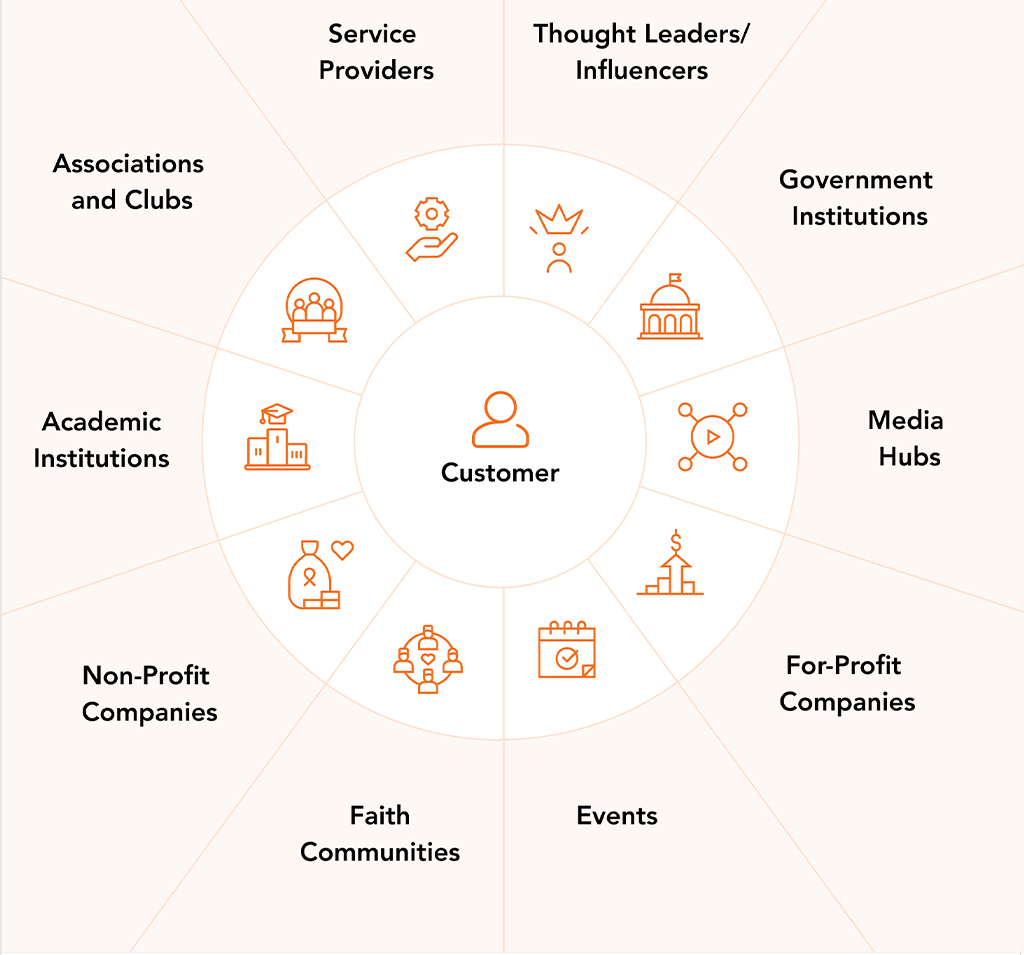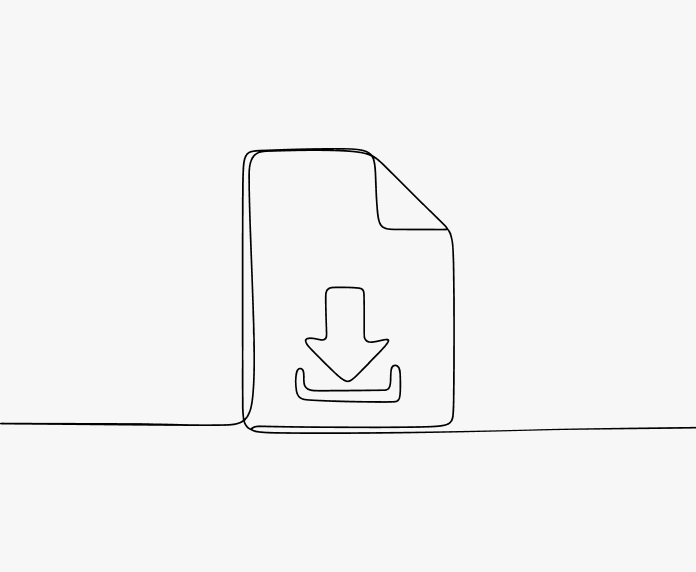
Why Agencies Need a
New Operating Model in 2025
optimistic about the future—down from
74% just two years ago.
You can feel it in the pipeline.
The deals that used to close in two weeks now stretch into two months.
Mid-scope surprises are multiplying. So are client asks.
And hiring? Let’s not even talk about hiring.
This isn’t just turbulence—it’s a structural shift in how digital agencies operate, scale, and manage partnerships.
Election-year uncertainty. AI whiplash. High-salary slowdowns.
And despite all the noise, only 21% of agency leaders cite AI’s impact on their relevance as a major concern.
The anxiety isn’t about automation—it’s about operations.
It’s about margin pressure that won’t ease. It’s about the mental tax of having to rejustify your team’s value every quarter—even when retention’s strong.
You don’t need more people.
You need better leverage.
And in 2025, leverage doesn’t come from headcount—it comes from scalable agency delivery models and partnerships designed for real capacity, not panic padding.
It comes from strategic partnerships—built to scale with your niche, preserve your margin, and protect your mental bandwidth.
Yet too many agencies still treat partnerships like Plan B.
Overflow vendors. Backup bandwidth.
That framing is outdated—and expensive.
86% of agency leaders are actively adjusting operations to respond to current market forces. With hiring freezes still common and salaries staying high, agencies are shifting not just who delivers—but how they deliver.
There are over 50,000 digital agencies in the U.S. and Canada—and nearly 179,000 worldwide, yet 88% of them have fewer than 50 employees.
Headcount isn’t your competitive advantage.
Leverage is.
This guide shows what needs to change—and how.
Agency Market Shifts in 2025:
The Storm Is Now the Climate
Lumpy scopes. Ghosted pitches. Burnt-out teams.
And they’re not alone.
According to the Agency Core 2025 report, 86% of agencies are actively adjusting operations to respond to market shifts, and 43% say finding new clients is harder than ever—nearly triple the 15% who said the same in 2023.

Add to that the $12.3 billion in political ad spend flooding media channels this year, and you’ve got a distorted, hyper-competitive attention landscape.
It’s not a rough patch.
It’s the new operating climate.
And if you’re still running your agency delivery model on 2020 assumptions—about hiring, bandwidth, or vendor use—you’re flying into headwinds.
Here’s the deeper risk:
Agencies are trying to fix a broken model with short-term hacks.
- Hiring more juniors doesn’t reduce senior strategy drag
- Squeezing freelancers doesn’t restore quality
- Stacking tools doesn’t replace strategic clarity
Control without capacity is a slow bleed.
Control with the wrong capacity? A hemorrhage.
Meanwhile, the agencies redesigning for 2025 aren’t just tightening scopes.
They’re rebuilding the entire delivery architecture—with partnerships as a first principle, not a fallback.
And the data backs them:
According to the Promethean 2025 Industry Report, 84% of digital agencies now identify as specialists, and those that expanded service lines grew by ~9.7% in 2024, compared to just ~1.1% growth for those who made no structural changes.
Translation: Adaptation pays. Stagnation starves.
One more myth to clear up before we move on: AI is not the villain here.
Only 21% of agency leaders cite AI as a major concern to their relevance.
The real issue is operational misalignment—not machine learning.
TLDR / Quick Recap—and What’s Coming Next
If your delivery model feels like it’s buckling under 2025 pressure…
You’re not imagining it.
- Agencies are battling margin erosion, scope volatility, and hiring freezes
- 86% are actively restructuring how they deliver—not just who delivers
- Yet only 25% of agencies say they’re very satisfied with the mix of strategic vs.
tactical work
A signal that most teams are still buried in execution—not operating at their highest value.
- Overflow vendors aren’t cutting it anymore—and “just hiring more” isn’t scalable.
What This Guide Breaks Down
Smart delivery starts with decision clarity—not headcount.
You’ll learn:
- The C3 Filter to decide what to build, buy, or partner for
- The Wharton Model to match partner types to your growth and risk profile
- How to:
- Spot the difference between vendors and true partners (before it costs you)
- Onboard with IP protection and brand clarity baked in
- Vet fit using a 10-question checklist
- Repair strained partnerships with a 7-step reset framework
Plus:
A full toolkit you can download, discuss with your team,
and use today.
And here’s the kicker:
According to Promethean’s 2025 Industry Report, agencies that expanded or repositioned services grew ~9.7% in 2024—while those that made no changes grew only ~1.1%.
You’ve already named the pressure.
Now let’s unlock the leverage.
Build, Buy, or Partner: A 2025
Framework for Agency Delivery
Let’s be blunt: most delivery decisions aren’t strategic.
They’re reactive.
The client adds a new stakeholder.
Your strategist is already maxed.
So you patch. You stretch. You scramble.
That’s not scale. That’s survival mode.
And in 2025, survival mode is a margin killer.
And Drew from the Agency Management Institute is accurate in his statement.
Most agencies hit a breaking point long before headcount becomes unmanageable. It’s not the team—it’s the model. And when the model breaks, the first symptoms show up in your delivery structure:
- Scope creep handled via Slack
- Senior staff pulled into junior execution
- Bandwidth solved by panic-hiring freelancers
That’s not strategy. That’s duct tape.
What You Need Is a Filter
The White Label IQ C3 Framework is a decision filter that helps you allocate delivery work based on what drives value, not what screams the loudest.
C3 Delivery Decision Matrix—Should You Build, Buy, or Partner?
Answer 3 quick questions about any task, service, or deliverable. The C3 Matrix will tell you whether to build it in‑house, partner for it, or buy/automate it.
-
Critical
Is this core to your agency’s strategic value?
Yes No -
Complex
Does it require judgment, coordination, or domain context?
Yes No -
Consistent
Does it show up predictably enough to justify systems?
Yes No
You just ran the filter above. Here’s what it looks like in action:
Real-World Example: How Smart Agencies Scale AI Services
AI is moving fast—faster than most agencies can hire or upskill for internally.
So what’s the smartest way to add AI services without burning cycles or credibility?
You partner.
He’s right.
Trying to build in-house AI capabilities—without the strategic need, volume, or margin to justify it—is a high-cost stall.
Buying off-the-shelf tech rarely delivers the consultative edge clients now expect.
But partnering? That lets you move early, deliver confidently, and grow into the opportunity without overextending your team.
That’s the C3 Filter in action.
AI isn’t just a technology decision—it’s a leverage test.
Why This Matters Now
That’s the cost of delay.
Or buy too soon—without a partner fit strategy.
Or partner too late—after the margin damage is done.
Choosing the Right Agency Partner: Wharton’s Strategic Model Explained
Knowing when to partner is only half the battle.
The bigger risk?
Picking the wrong partner type for the role you actually need them to play.
This is where most agency partnership pain begins—not with the vendor, but with the misfit.
You bring in a white-label team for “capacity”—but secretly expect them to elevate strategy. You hire a freelancer hoping for innovation—but scope them into silence. You get misfires, mismatched expectations, or worse: erosion of trust.
That’s not bad intent.
It’s bad alignment.
Wharton’s Partnership Model: A 2×2 for Fit
Wharton professor Harbir Singh, a global expert on corporate alliances, offers a practical model for avoiding mismatched partnerships:
Map the type of partner you need based on two factors:
- Your Strategic Intent Are you trying to learn, test options, or lock in a long-term positioning advantage?
- The Market Uncertainty You’re Facing Are you operating in a fast-moving, unpredictable landscape—or one that’s stable and mature?
This isn’t just academic.
It’s the lens that helps you stop asking “Can they do the work?” and start asking: “Are they the right partner for the role this moment requires?”
Types of Agency Partnerships: Window, Options, and Positioning Models
Not all partners are built to scale with you.
Some are meant to explore. Some are meant to extend. And a rare few? They’re meant to embed.
The key isn’t just finding capable partners. It’s aligning the right type of partnership to the moment you’re in—and the role your client needs you to play.
That’s where the Window–Options–Positioning model comes in. Built on Wharton’s foundational alliance strategies, this framework helps you design partnerships that match uncertainty, intent, and trust.
1. Window Partnerships
Use When: You’re exploring emerging services, platforms, or ideas
Strategic Role: Observe and learn—without overcommitting
Window partners give you visibility into new terrains—like AI, Web3, or industry-specific formats—without forcing you to fully invest. Think of it as running a reconnaissance mission with a guide.
- A design studio for AI-assisted prototyping
- A dev partner for Shopify headless builds
- A production shop for social-first video
-
Low cost, fast start
-
Risk: Leakage of internal methods or accidental brand exposure
As Wharton’s Harbir Singh notes, Window partnerships thrive in high-uncertainty environments. They keep you in the flow of innovation without drowning your ops.
2. Options Partnerships
Use When: You’re placing smart bets—and want the ability to scale fast
Strategic Role: Build flexible capability—without locking in
Options partnerships sit one rung above Windows. You’re not just testing the water—you’re building a dock.
This is where many agencies partner for second-tier platforms, emerging verticals, or high-potential but lower-volume service lines. It’s your ability to say “yes” to more—without overwhelming the core team.
-
Moderate investment, expandable structure
-
Risk: Organizational drag—unclear ROI leads to slow
decisions or half-commits
Singh’s research frames this as the “platform of possibilities”—useful, but vulnerable to inertia when clarity fades.
3. Positioning Partnerships
Use When: You need execution that protects your brand and margin
Strategic Role: Embed for strategic advantage—not just extra hands
This is your invisible extension—the partner who moves with you, not just for you. They’re inside your workflows, onboarded to your QA, fluent in your tone and tools.
- They work as if they’re in the next room—not across the globe
- They anticipate client expectations before they’re stated
- They execute like insiders because, in practice, they are
-
Deep alignment, scalable trust
-
Risk: Disengagement if treated like a vendor or kept out of planning loops
As Singh puts it: Positioning partnerships only work when complementary capabilities integrate to create real market advantage.
From Fit to Flow: Your Partner Should Map to the Client’s Ecosystem
But here’s where most agencies miss: they build partnerships based on internal need—not client reality.
That’s a mistake.
As IP Agency owner Pamela Slim frames it in The Widest Net, every client already has a help ecosystem—tools they trust, advisors they lean on, and partners they already use.
Smart agencies don’t work around that. They work within it.
Slim’s Ecosystem Wheel puts the client at the center, with ten categories radiating outward—ranging from associations to events to software. Every spoke is an opportunity to align your partnerships with where trust already flows.

Based on Pam Slim’s Ecosystem Wheel
Window, Options, and Positioning partnerships don’t just improve delivery. They embed you in the way your client buys, builds, and grows.
They don’t just fill capability gaps. They make you frictionless in the flow of how your client already operates.
Final Thought
The biggest partnership failures?
They happen when you misassign the role.
- A Window partner slotted into core delivery collapses under pressure.
- A Positioning partner treated like overflow walks away quietly—taking your processes with them.
Your next move isn’t just about finding a partner.
It’s about defining the right kind—and the right fit for the role this moment requires.
How to Evaluate Strategic Fit in Agency Partnerships (Before It Costs You)
By now, you know when to partner—and what type of partner fits your intent.
But even the “right” type can be wrong if the foundation is weak.
According to Harvard Business strategist Benjamin Gomes-Casseres, author of Remix Strategy, effective partnerships—whether a joint venture or a white-label contract—are governed by three simple laws:
- Create Joint Value
- Be Governed to Realize It
- Share Rewards Proportionally
Miss any one of these, and even a great partner can become a drag on your margins.
Run the Fit Test Now
Don’t just skim the laws—score your current or potential partner
against them.
Answer 10 quick questions below and get your Partner Fit Score,
complete with recommendations for next steps.
Strategic Fit Test — Is This the Right Partner?
Rate 10 statements across Joint Value, Governance, and Reward Sharing. Get your Partner Fit Score and what to do next.
Proceed cautiously.
- Address governance gaps.
- Limit client exposure.
- Reassess in 30–60 days.
Most partnerships don’t fail because of talent. They fail because of misalignment. The Fit Score you just calculated gives you a forward-looking lens—not just a rearview check.

Don’t Sign Yet If You Can’t Answer:
- What unique value are we creating together?
- How is that value being measured?
- Are both sides equally invested in the outcome?
Because vague answers now = expensive surprises later.
Your margin—and your reputation—depend on it.
Beyond the Scope: Why Even Great Work Can Fail Without the Right Partners
Agencies obsess over getting the deliverable right.
Strategy decks. Brand refreshes. Content calendars.
But sometimes, the work still falls flat—even when you nail it.
Why?
Because your deliverable was only one piece of a bigger puzzle—and the other pieces never showed up.
Susan Baier, founder of Audience Audit and co-lead of the Agency Edge and Agency Core studies, puts it bluntly:
Most agency leaders focus (appropriately) on solving the problem they were hired to fix. But that focus can create blind spots:
- A lead-gen campaign tanks because the sales process can’t convert
- A gorgeous new site underperforms because no SEO was implemented
- A strategy sprint stalls out because the client never aligned their internal team
You didn’t fail.
But it feels like you did—to the client, to the team, to the
bottom line.
Strategic Partnerships as Outcome Insurance
The best agencies don’t try to do it all.
They don’t throw more people at the problem.
They bring in the right partners at the right time—before the damage
is done.
That’s the real power of strategic partnerships:
- Partners who complement your scope, not compete with it
- Allies who extend the value of your work, not dilute it
- Integration that makes success feel seamless to the client
Whether you engage partners upstream (during strategy) or downstream (in execution), the goal is the same: better outcomes, shared credit, and longer retention.
The Takeaway
Your work shouldn’t fail because someone else dropped the ball.
And your client shouldn’t have to be the one piecing it all together.
Strategic partnerships aren’t just an ops decision.
They’re an outcome decision. Build your partnerships accordingly.
Vendor vs. Strategic Partner:
The Line That Protects Your Margin
Sadly, the word “partner” gets thrown around like confetti.
But the difference between a true strategic partner and a transactional vendor? It’s the difference between compounding trust—and quiet failure.
Most vendors follow scope.
Partners shape outcomes.
Here’s the contrast—as clearly as we can draw it:
| Trait | Vendor | Strategic Partner |
|---|---|---|
| Role | Task executor | Outcome co-owner |
| Visibility | Behind the curtain | Embedded and accountable |
| IP Awareness | Low—follows files | High—protects margin, message, and method |
| Proactivity | Reactive to scope | Flags risk, proposes solutions |
| Flexibility | Resists change | Adapts with clarity |
| Value Impact | Cost savings | Value expansion |
And here’s what The State of Alliance Management says:
Why?
Because too many agencies call someone a “partner”…
But manage them like a vendor.
No shared goals.
No co-ownership.
No upside alignment.
And when scopes shift—as they always do—that relationship breaks.
The best agencies draw the line early.
Not to gatekeep—but to clarify.
Partners aren’t just reliable.
They’re strategic.
And they make you better.
Agency Partnership Success: The Trifecta of Fit, Trust, and Flexibility
When partnerships work, they work like compound interest:
Tighter execution. Better decisions. Smoother delivery.
But when they break, it’s almost never about talent.
It’s about misalignment.
According to BDO’s 2024 Alliance Management Study, the top drivers of partnership failure are misfit, mistrust, and rigidity.
After dozens of interviews and diagnostics, the strongest agency partnerships consistently share this trifecta:
1. Fit → Alignment in Process, Pace, and Priorities
Fit isn’t about “getting along.”
It’s about operational match.
Ask yourself:
- Do they slot into your systems—or slow them down?
- Can they match your volume, speed, and QA expectations?
- Do your teams collaborate without translation?
Misfit piles up in project delays, crossed wires, and morale erosion.
2. Trust → Earned Confidence in Execution and Judgment
Trust isn’t blind faith.
It’s knowing they’ll make the right call when the brief gets murky.
It shows up in the micro-moments:
- Flagging scope risks early
- Clarifying ambiguous asks without guessing
- Fixing errors—before the client notices
3. Flexibility → Adaptive Strength, Not Just Speed
In 2025, rigid delivery is risky delivery.
Your partner has to flex without folding:
- Shift bandwidth mid-sprint
- Adapt deliverables as client priorities evolve
- Respect brand nuance on the fly
Flexibility isn’t about chaos tolerance.
It’s about having systems that bend without breaking.
Partnerships are living systems—not fixed contracts.
And when one of these three pillars is missing?
Even the best-fit partner will underperform.
Before we move on, here’s a reality check:
Build smart.
But more importantly, build for evolution.
Collaborative Advantage—How Real Partnerships Show Up
You’ve seen the frameworks.
You’ve filtered for fit, trust, and flexibility.
But what does a strategic partner actually look like in the middle of a messy sprint, a scope pivot, or a last-minute client fire?
It’s not about perfect decks or polished standups.
It’s about alignment that holds when things get chaotic.
Kanter states that business alliances are living systems… not controlled by contracts, but by dense interpersonal connections.
In high-performing agencies, strategic partners aren’t hidden backstage.
They’re visible. Embedded. Accountable.
From first brief to final mile.
The 5 Levels of Partnership Integration
Not every partner is truly a partner. Some are vendors you pass work to. Others are so woven in that clients can’t tell where your team ends and theirs begins.
The difference? Integration.
The depth of integration determines whether your margins are protected or eroded. It shapes whether clients see you as in control—or as dependent.
Run the Integration Ladder Now
Instead of guessing, plot your current partner on the ladder below. You’ll see:
- What’s working at your current level
- Where the risks are
- And the moves you can make to level up
Where Does Your Partner Sit on the Integration Ladder?
Partnerships evolve through five stages. Select the level that best describes your current relationship to see the risks of staying put—and the moves that take you higher.
You’re at
- Fragile if people leave or go on leave.
- Coverage gaps and inconsistent expectations.
You’re at
- Strategy and trust may lag behind process.
- Easy to get stuck in ticket-taking.
You’re at
- Still vendor-ish; misses upsell/retention levers.
- Pipeline and planning remain siloed.
You’re at
- Misaligned incentives stall progress.
- Weak exec sponsorship erodes momentum.
You’re at
- Backslide if onboarding/training isn’t maintained.
- Scope drift if boundaries blur.
The smartest agencies don’t settle for “good enough” integration. They use the ladder to keep moving up—from transactional to strategic to cultural.
Because when your partner is indistinguishable from your own team? That’s when delivery becomes margin-protecting, not margin-draining.
The higher your partner is on this ladder, the less friction your team absorbs.
And the benefits are measurable:
Ask your team:
- Do we involve this partner in planning—or just handoffs?
- Would we trust them on a client call, unsupervised?
- When something goes sideways—do we solve it together?
If the answer is “not really”…
You haven’t partnered. You’ve subcontracted.
And subcontracting doesn’t scale.
Partnership does.
Don’t Let Exclusivity Become a Trap
Exclusive partnerships sound great—until they don’t.
What starts as a win-win can quietly harden into a cage.
- Limited delivery options
- One point of failure
- No leverage in renegotiation
- Dependency that’s hard to unwind
The intent behind exclusivity is loyalty.
But loyalty, without structure, turns into risk.
Especially in fast-moving agency environments, hard-coded exclusivity often creates:
- Complacency without accountability
- Slower pivots when scopes evolve
- Pressure on one partner to cover every edge case—even when they shouldn’t
And the data backs the caution:
Translation: If you don’t design for evolution, the relationship may quietly design itself—toward misalignment, dependency, or exit.
Build Flexible Loyalty Instead
Exclusivity isn’t required to protect the work.
What’s required is:
- Shared success metrics
- Scoped communication rights
- Clear escalation paths
- Earned trust over time
Loyalty isn’t a contract clause.
It’s a rhythm of reliability.
Structure it around value delivered—not promises made.
Protecting Your Agency’s IP, Brand, and Margin: The Guardrails Every Partnership Needs
Even the best-fit partner can become a liability—if you don’t set clear legal guardrails from day one.
Strategic partnerships don’t just scale your output.
They touch everything:
- Your internal systems
- Your client experience
- Your intellectual property
- Your reputation—and retention
That’s why legal protections aren’t just contract formalities.
They’re operational insurance.
Legal Clarity Creates Trust
Sharon Toerek, founder of Toerek Law and legal advisor to creative agencies, puts it simply:
In a recent presentation with White Label IQ President Brian Gerstner, Sharon shared two must-use tools for agencies navigating partnerships:
- Strategic Alliance Conversation Checklist
- Strategic Alliance Contracts Checklist
These tools walk you through the critical missteps most agencies make:
- Who owns the relationship? Who invoices? Who communicates with the client?
- What happens if one partner pitches additional work?
- How is IP licensed or transferred—and who gets display rights in their portfolio?
These aren’t technicalities.
They’re trust structures.
The 5 Layers of Partnership Protection
Here’s how you protect what matters—not just legally, but operationally.
1. Legal & IP Safeguards
Use NDAs with teeth—not templates.
Clarify IP ownership up front, and ensure your client-facing SOW aligns with your back-end partner agreements.
Sharon’s tip:
When delivering work that includes retained intellectual property or proprietary methods, use an IP License Agreement to define boundaries and reuse rights.
2. File Control & Access Hygiene
Set up centralized, permission-based systems. Never share access casually. Revoke permissions the moment a relationship ends.
Your Google Drive shouldn’t be a buffet.
3. Usage Boundaries
Define:
- Whether partners can reuse assets across clients
- What white-label roles allow—and what they don’t
- How attribution works (and who controls it)
4. Margin Discipline
Cheap work that burns time isn’t cheap. It’s margin theft.
Track true cost vs. value.
Establish internal margin floors—especially for partner work.
Define how out-of-scope work is handled and who sets rates.
5. Brand & Voice Protection
Onboard every partner into your brand tone, QA process, and delivery expectations.
If they touch the client—even invisibly—they need to sound like you, work like you, and care like you.
Treat onboarding like client prep.
Because in many ways, it is.
Final Word: Protect to Scale
You can’t retroactively fix trust.
Set these guardrails before the first file is shared.
Because what they protect isn’t just your assets—it’s your ability to scale without regret.
Whether you’re in a referral, white-label, or teaming relationship, the legal frameworks you put in place define the trust you’ll rely on when the work gets complex.
As Sharon Toerek makes clear: Protecting your agency isn’t about control. It’s about clarity. And in 2025, clarity is your moat.
Agency Partner Onboarding: What the First 90 Days Should Look Like
You’ve vetted the partner. You’ve aligned on value, governance, and guardrails.
Now comes the part that actually determines success: onboarding. Because here’s the truth most agency leaders forget: You don’t just hire a partner. You train them into your system.
And when that training is rushed, shallow, or vague?
- Rework skyrockets
- Trust erodes
- Scope creep sneaks in—disguised as “helpful flexibility”
A solid onboarding plan doesn’t slow you down.
It protects you from firefighting later.
The 90-Day Onboarding Framework
Break onboarding into three deliberate phases:
0–30 Days: Foundation
Goal: Establish clarity, access, and expectations
- Grant and gate access (tools, brand kits, permissions)
- Set working agreements (timelines, escalation paths, comms rhythm)
- Align on deliverable formats, tone, and “final mile” standards
- Share examples of “what great looks like”—both internally and for your clients
Bonus: Define boundaries upfront
30–60 Days: Sync & Scale
Goal: Test systems under real pressure
- Are feedback loops fast and useful?
- Are deliverables hitting target without handholding?
- Is ownership clear when scopes shift?
Use this phase to:
- Spot recurring friction
- Test team alignment
- Start predicting gaps—not reacting to them
60–90 Days: Optimize
Goal: Systematize what works
- Run a formal partnership retro—both sides weigh in
- Create SOPs, playbooks, or templates based on wins
- Share forecast visibility and upcoming shifts
- Decide whether to scale, specialize, or maintain
Don’t treat Day 90 as the end.
Treat it as the launchpad.
Pro Tip: Assign an Integration Owner
If there’s one move that prevents drift before it starts—it’s this:
Designate a single human to lead the onboarding.
(Not a Slack channel. Not a group thread.)
That person should:
- Champion the plan internally
- Own the feedback loop
- Protect your delivery standards
A strong integration owner buys back hours for leadership—and builds the trust that keeps partners around.
The ROI of Strategic Partnerships for Agencies: Innovation, Growth, and Margin You Can Measure
Strategic partnerships aren’t just about bandwidth.
They’re about upside.
When the right partner is embedded early and aligned deeply, something powerful happens:
- Feedback loops tighten
- Ideas get sharper
- Delivery doesn’t just hit deadlines—it hits outcomes
Your team stops playing defense.
Your services get smarter.
Your margin starts breathing again.
Partnership Isn’t Just Capacity—It’s Capability
- Want to offer a new service line without hiring a full team?
- Need to test a complex idea with less risk?
- Trying to win bigger accounts without overloading ops?
That’s not outsourcing.
That’s co-creation.
Let’s Talk ROI—The Real Kind
According to BDO, companies in the top quartile for multilateral alliances saw 4.5× more revenue growth than those in the bottom quartile. And organizations with the strongest reliance on alliances? 27% three-year revenue growth, compared to flat growth for low-reliance peers.
According to Promethean’s 2025 Industry Report, Agencies that expanded or repositioned services in partnership with others saw ~9.7% growth in 2024, vs. just ~1.1% for those who made no structural changes.
In short: Structure scales. And partnerships outperform patchwork.
Talking Point for Internal Teams
“We’re not hiring for output. We’re partnering for innovation and scale.”
Say that in your next planning meeting—and see what opens up.
Agency Partner Vetting Checklist: How to Avoid the Costliest Kind of Misfit
Most partnerships don’t implode on Day One.
They decay—slowly, silently, and expensively.
Maybe they sounded sharp on the sales call.
Maybe their portfolio looked great.
Maybe they even came highly recommended.
But six weeks in?
- Deliverables need “just one more revision”… every time
- Ownership is blurry
- Deadlines slip—quietly
- Your team ends up cleaning it up anyway
That’s not a partner.
That’s a vendor in disguise—and your ops team is footing the bill.
Why This Checklist Matters
This checklist protects you from those risks before they start.
Use it before you sign, and again as a quarterly audit for existing partners.
What to Check (Before the Handshake)
Vet your partner across these 10 dimensions:
- Communication rhythm
- Brief clarity
- File handoff and version control
- Ownership of edge cases and surprises
- QA process reliability
- Strategic thinking—not just execution
- Platform and tool integration
- Escalation protocol clarity
- Brand tone and voice familiarity
- Offboarding readiness and system hygiene
Optional Add-On: Score It
Rate each item from 1–5.
Use the total as a decision lens:
- < 35 = Red flag
- 35–44 = Needs refinement
- 45+ = Worth investing in
Fixing Broken Agency Partnerships: How to Reset Before You Replace
Not every misfire means it’s time to walk away.
But if you don’t know how to reset a partnership when things go sideways, you’ll end up cycling through vendors—and burning through time, trust, and margin.
Here’s what the data says: According to BDO’s 2024 Alliance Management Study, most partnership failures stem from misalignment, unclear goals, and poor governance.
And from Harvard research: Nearly 80% of joint ventures end in a sale by one partner—usually not because of one blowup, but because of a slow breakdown in structure, trust, or expectations
The good news?
You can fix a strained partnership—if you move early, and lead clearly.
7 Steps to Reset a Strained Partner Relationship
Adapted from Rebecca Zucker’s strategic repair model—tuned for agencies.
1. Go Live and Direct
Skip the email thread. Don’t Slack around the issue.
Initiate a direct conversation—ideally face-to-face or camera-on.
2. Name the Shared Investment
Begin with alignment, not accusation.
“We both want this to work. That’s why I want to recalibrate now.”
3. Describe the Pattern—Not the Person
Focus on recurring gaps, not personality flaws.
“We’ve missed our QA window in three straight sprints.”
“You keep dropping the ball.”
4. Invite Their Viewpoint
Ask where they’re feeling friction.
What are they seeing that you might be missing?
This builds buy-in—and often reveals easy fixes.
5. Reset What Good Looks Like
Reclarify formats, cadence, tone, escalation protocols.
Don’t assume alignment. Reconfirm it out loud.
6. Create New Norms—Fast
Tighter briefs. Mid-sprint reviews. Tool cleanup.
Whatever you agree on, make it operational within a week.
7. Document the Reset + Revisit in 30 Days
No vague takeaways. Put the new agreements in writing.
Then set a 30-day check-in to review progress—with both teams in the room.
Final Word
Most partnerships don’t break all at once.
They break in the little moments no one names.
This framework gives you a way to name them—without blame—and rebuild before you walk away.
Strategic Partnership Toolkit for Agencies: Every Framework. One Place. Ready to Use.
These are the same tools agencies use to scale smarter, vet faster, and protect their brand—without drowning in operational chaos.
Everything described or listed here is grounded in trusted research and field-tested strategy—built on insights from:
You Don’t Need More People. You Need Better Leverage.
Most agencies don’t break because they lack talent.
They break because the delivery model can’t hold the growth.
- 86% of agency leaders are already restructuring operations
- Only 25% are truly satisfied with the mix of strategic and tactical work
The gap?
It’s not capacity.
It’s clarity.
And strategic partnerships—done right—give you that clarity:
- What to build in-house
- What to buy off the shelf
- What to partner for—so you scale without the drag
The tools are in your hands:
-
Frameworks to filter fit
-
Guardrails to protect what matters
-
Onboarding plans to prevent regret
-
Repair protocols to preserve trust
-
ROI data to make the case—to yourself, your team, your CFO
You don’t need to guess anymore.
You need to lead.
And if this guide helped you see your agency a little clearer—imagine what the right partner could help you build next.





